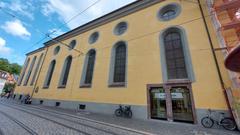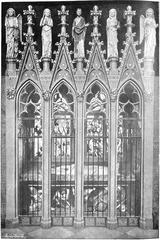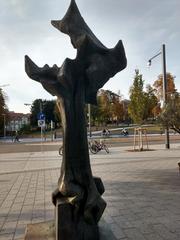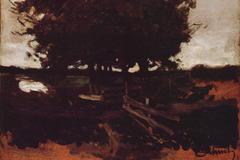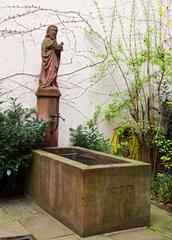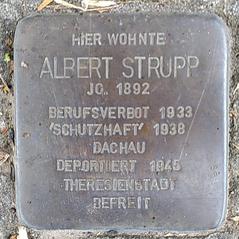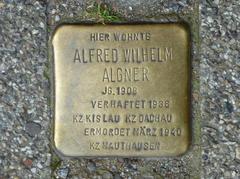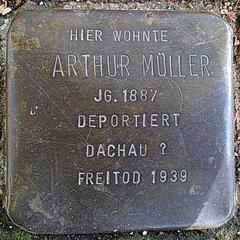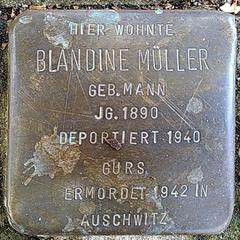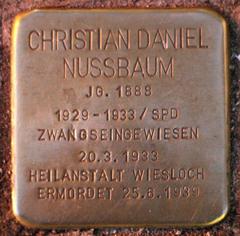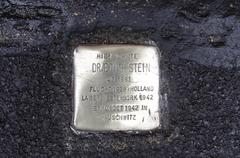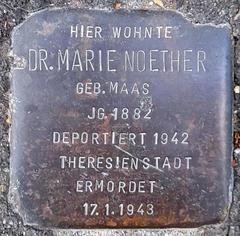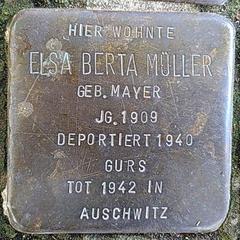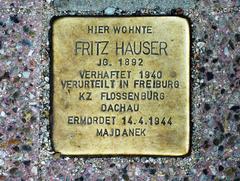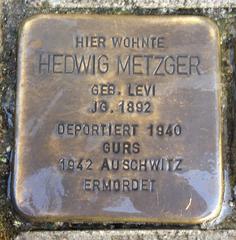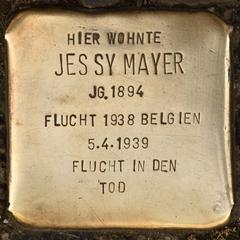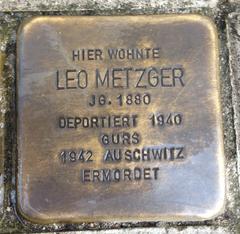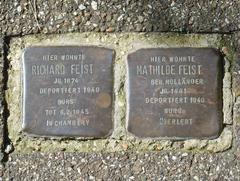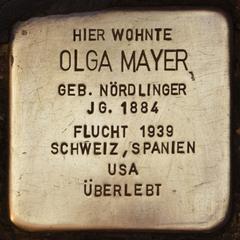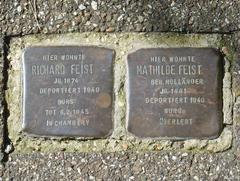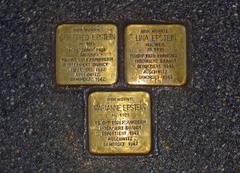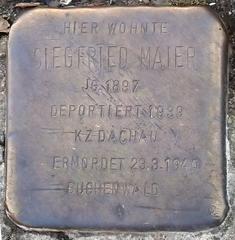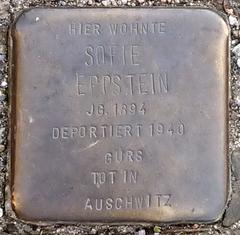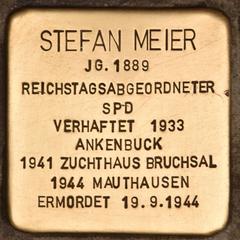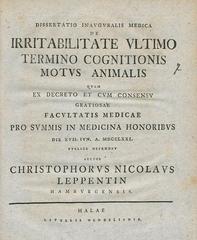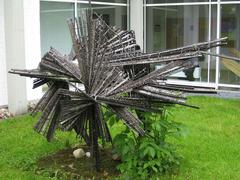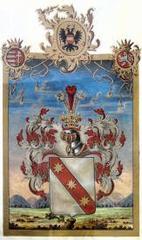Stolperstein Dedicated To Christian Daniel Nussbaum
Visiting the Stolperstein for Christian Daniel Nussbaum in Freiburg im Breisgau, Germany: Guide, History, and Visitor Information
Date: 14/06/2025
Introduction
The Stolperstein commemorating Christian Daniel Nussbaum in Freiburg im Breisgau stands as a powerful reminder of personal resistance and suffering during the Nazi regime. As part of the world’s largest decentralized memorial, initiated by artist Gunter Demnig in 1992, Stolpersteine (“stumbling stones”) are brass plaques embedded in pavement, marking the last freely chosen residences of victims of National Socialism. The Stolperstein for Nussbaum, situated at both Barbarastraße 1 and Landsknechtstraße 9 in Freiburg, honors his memory as a Social Democratic politician and victim of Nazi persecution, and invites visitors to reflect on his life within the fabric of everyday city life (stolpersteine.eu; Traces of War; Wikipedia: Stolperstein).
This guide provides historical context, detailed visitor information, accessibility tips, and resources to help you make the most of your visit to the Stolperstein for Christian Daniel Nussbaum in Freiburg im Breisgau (Freiburg Tourism; Tablet Magazine).
Contents
- What is a Stolperstein?
- The Stolperstein Project: Origins and Philosophy
- Christian Daniel Nussbaum: Historical Background
- Location and Visiting Information
- Barbarastraße 1
- Landsknechtstraße 9
- Inscription Details
- Visitor Tips and Accessibility
- Special Events and Tours
- Nearby Attractions
- Controversies and Community Perspectives
- Frequently Asked Questions (FAQ)
- Additional Resources
- Conclusion
What is a Stolperstein?
Stolpersteine (“stumbling stones”) are small brass plaques set into pavements across Europe to commemorate individuals persecuted by the Nazi regime. Initiated by Gunter Demnig, the project decentralizes memorialization, bringing the memory of victims directly into the flow of daily life. Each Stolperstein is inscribed with the name, birthdate, fate, and, if known, death of a victim, marking the place where they last lived or worked freely (stolpersteine.eu; Wikipedia: Stolperstein).
The Stolperstein Project: Origins and Philosophy
Founded in 1992, the Stolperstein Project was conceived as a decentralized alternative to large-scale Holocaust memorials. The first stone was placed in Cologne, and the idea quickly spread, with over 100,000 Stolpersteine installed by June 2023 in more than 1,200 cities across Europe (pragueviews.com). The project’s philosophy centers on restoring the identities of Nazi victims to public memory and encouraging passersby to “stumble” upon history, promoting personal reflection and historical awareness (germany.info).
Christian Daniel Nussbaum: Historical Background
Christian Daniel Nussbaum (b. 1888) was a prominent member of the Social Democratic Party (SPD) and served in the Baden State Parliament from 1929 to 1933 (Traces of War). He moved to Freiburg in 1927 and was married to Emma Nussbaum (née Eberle), who was Jewish. After the Nazis seized power, Nussbaum became a target of political persecution. On 17 March 1933, when police entered his apartment to arrest him, Nussbaum, fearing for his life, shot the officers in self-defense. Both officers died, and Nussbaum was subsequently institutionalized in the Wiesloch Psychiatric Institution, where he remained until his suspicious death on 25 June 1939, believed to be a victim of the Nazi euthanasia program.
His Stolperstein not only commemorates his personal courage and suffering but also represents the broader story of political and racial persecution during the Nazi era.
Location and Visiting Information
Barbarastraße 1
- Address: Barbarastraße 1, Freiburg im Breisgau, Germany
- Coordinates: 48.004053 latitude, 7.839863 longitude
- Significance: The last freely chosen residence of Christian Daniel Nussbaum before his arrest
- Access: The Stolperstein is embedded in the pavement near the building entrance, accessible 24/7 without any fee or ticket (Traces of War).
Landsknechtstraße 9
- Address: Landsknechtstraße 9, Freiburg im Breisgau, Germany
- Significance: The address where Nussbaum lived the longest in Freiburg. A second Stolperstein was placed here in 2004 (Traces of War).
- Access: Publicly accessible at all times.
Both sites are within walking distance of Freiburg’s city center and are wheelchair accessible.
Inscription Details
Each Stolperstein is a 10x10 cm brass plate set on a concrete block. The inscription for Christian Daniel Nussbaum reads:
Hier wohnte Christian Daniel Nussbaum
Jg. 1888
1929-1933 / SPD
Am 20.3.1933 zwangsweise in die Psychiatrische Anstalt Wiesloch eingewiesen
Ermordet 25.6.1939
Translation:
Here lived Christian Daniel Nussbaum
Born 1888
1929-1933 / SPD (Social Democratic Party of Germany)
On 20 March 1933, forcibly admitted to Wiesloch Psychiatric Institution
Murdered 25 June 1939
Visitor Tips and Accessibility
- No Tickets or Fees: The Stolpersteine are located in public spaces and can be visited free of charge, at any time.
- Accessibility: Both locations have level pavements and are suitable for wheelchair users.
- Best Time to Visit: Early mornings or late afternoons for a more peaceful experience.
- Etiquette: Pause to read the inscription. Visitors often leave small stones, flowers, or candles as tokens of remembrance.
- Photography: Discreet photography is welcomed; respect local residents and avoid blocking entrances.
- Maintenance: Volunteers regularly clean the brass plaques, especially on remembrance days. Visitors may gently clean the stones with a soft cloth if they wish.
Special Events and Tours
- Guided Tours: Freiburg offers guided Stolperstein tours, providing in-depth context and stories behind the memorials. These can be arranged through local tourism offices or community organizations (Freiburg Tourism).
- Commemorative Events: Annual ceremonies, especially on Holocaust Remembrance Day, may include the laying of new stones or cleaning events.
Nearby Attractions
While visiting the Stolperstein, consider exploring Freiburg’s historical sites:
- Freiburger Münster (Cathedral)
- Augustinermuseum
- Freiburg’s Old Town
All are easily accessible via public transport or on foot.
Controversies and Community Perspectives
Despite the project’s acclaim, the placement of Stolpersteine has prompted debate. Some critics argue that memorializing victims in pavements, where the stones may be stepped on, is disrespectful (Leo Baeck Institute). Certain Jewish communities and some property owners have opposed installations, resulting in local bans or alternative memorials, particularly in Munich. Vandalism and concerns about maintenance have also arisen. Nevertheless, the Stolperstein project continues to expand, supported by volunteers and community advocates (Tablet Magazine).
Frequently Asked Questions (FAQ)
Do I need tickets to visit Stolpersteine?
No, Stolpersteine are installed in public sidewalks and are accessible to all, free of charge.
Are guided tours available?
Yes, Freiburg and other cities offer guided Stolperstein tours. Check local tourism websites for current schedules.
Can I take photographs?
Yes, photography is encouraged, but please be respectful of the surroundings and residents.
Is the Stolperstein wheelchair accessible?
Yes, both Barbarastraße 1 and Landsknechtstraße 9 have level pavements suitable for wheelchair users.
Are there other Stolpersteine in Freiburg?
Yes, Freiburg hosts several Stolpersteine honoring diverse victims. Exploring them provides broader historical perspective.
Additional Resources
- Stolpersteine in Freiburg Official Website
- Freiburg Tourism Office
- Stolpersteine Project Official Site
- Traces of War – Stumbling Stone Barbarastraße 1
- Wikipedia: Stolperstein
- Tablet Magazine: Vanished Stumbling Stones
For virtual tours, audio guides, and interactive maps, explore local tourism websites or download the Audiala app for a self-guided experience.
Conclusion
Visiting the Stolperstein for Christian Daniel Nussbaum in Freiburg im Breisgau is a meaningful way to engage with the city’s past and honor those who resisted oppression. These memorials transform ordinary city spaces into sites of remembrance, ensuring that the stories of victims like Nussbaum remain present in our collective consciousness. Take time to reflect at these sites, participate in guided tours or commemorative events, and explore the broader context of Freiburg’s historical landscape.
By doing so, you contribute to the act of remembrance and help keep the lessons of history alive for future generations.
Sources and Further Reading
- Stolpersteine Project: History, Locations, and Visitor Information
- Christian Daniel Nussbaum Monument: Visiting Information, History, and Travel Tips
- Visiting the Stolperstein for Christian Daniel Nussbaum in Freiburg: Location, History, and Visitor Tips
- Visiting the Stolperstein of Christian Daniel Nussbaum in Freiburg: History, Significance, and Visitor Information
- Stolperstein (Wikipedia)
- Vanished Stumbling Stones, Tablet Magazine
